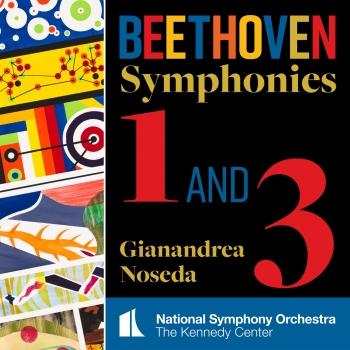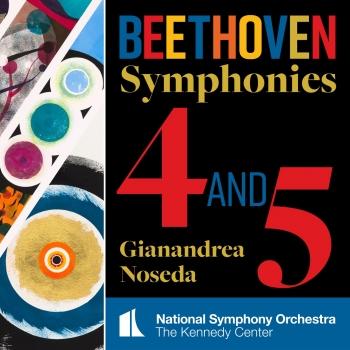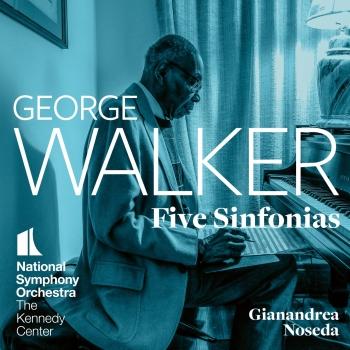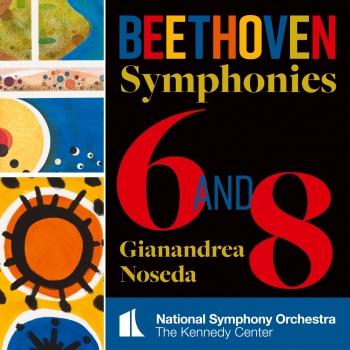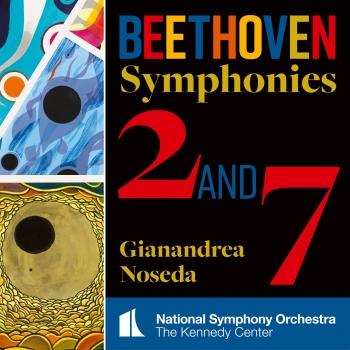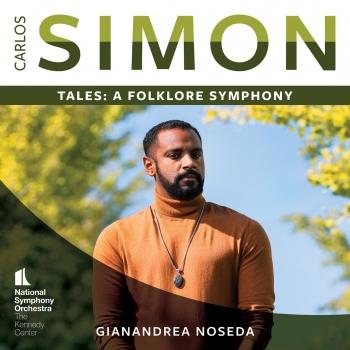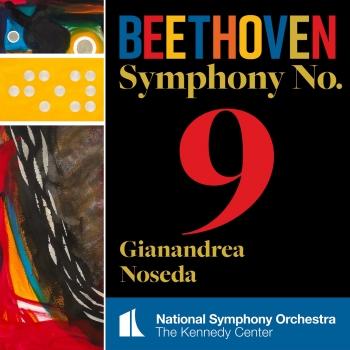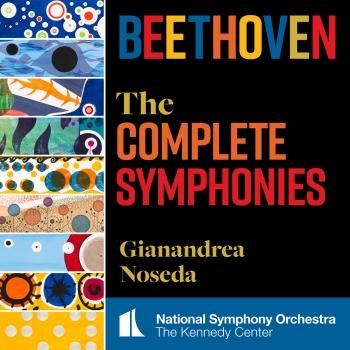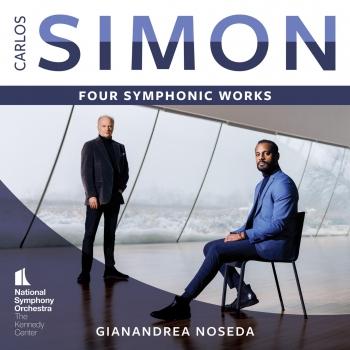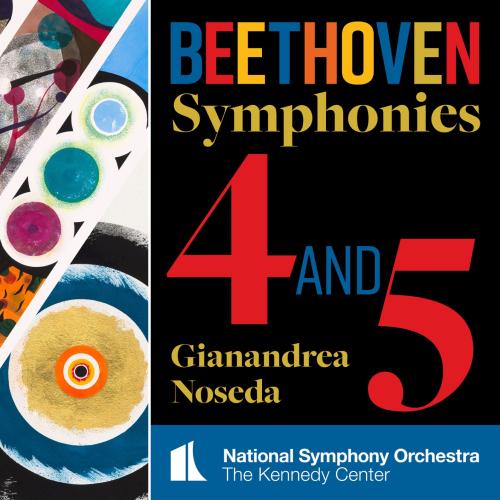
Beethoven: Symphonies Nos 4 & 5 National Symphony Orchestra, Kennedy Center & Gianandrea Noseda
Album info
Album-Release:
2023
HRA-Release:
19.05.2023
Label: National Symphony Orchestra
Genre: Classical
Subgenre: Orchestral
Artist: National Symphony Orchestra, Kennedy Center & Gianandrea Noseda
Composer: Ludwig van Beethoven (1770-1827)
Album including Album cover Booklet (PDF)
- Ludwig van Beethoven (1770 - 1827): Symphony No. 4 in B-Flat Major, Op. 60:
- 1 Beethoven: Symphony No. 4 in B-Flat Major, Op. 60: I. Adagio - Allegro vivace 10:34
- 2 Beethoven: Symphony No. 4 in B-Flat Major, Op. 60: II. Adagio 09:25
- 3 Beethoven: Symphony No. 4 in B-Flat Major, Op. 60: III. Menuetto. Allegro vivace 05:17
- 4 Beethoven: Symphony No. 4 in B-Flat Major, Op. 60: IV. Allegro ma non troppo 06:26
- Symphony No. 5 in C Minor, Op. 67:
- 5 Beethoven: Symphony No. 5 in C Minor, Op. 67: I. Allegro con brio 06:40
- 6 Beethoven: Symphony No. 5 in C Minor, Op. 67: II. Andante con moto 08:49
- 7 Beethoven: Symphony No. 5 in C Minor, Op. 67: III. Scherzo. Allegro 04:41
- 8 Beethoven: Symphony No. 5 in C Minor, Op. 67: IV. Allegro 10:28
Info for Beethoven: Symphonies Nos 4 & 5
“Beethoven’s symphonies have moved millions of people. One evening, at a concert almost 250 years after his birth, Beethoven’s work moved me to paint them. The idea of creating art specifically to view while listening to Beethoven’s symphonies, compelled me to spend a year researching, listening, and painting. The result is nine abstractions, a visual art piece for each symphony, rendered in panels, whose sizes represent the lengths of each movement.
Through this project, I got to know Beethoven in a new way. When you listen to a symphony you are invited to a dialogue with its creator. I had the opportunity to see his technique change over his career and to feel the journey of his musical notes.
Symphony No. 4 in B-flat major, Op. 60 (1806)
Beethoven’s career as a composer spanned some 40 years, from his youthful essays to the last string quartets. His output, however, was not evenly distributed over those decades. There were years when he composed little or nothing at all; at other times he wrote incredible amounts of great music over a remarkably short period of time. During such periods, it is hard to reconcile Beethoven’s extreme speed with the usual image of the composer toiling endlessly over his sketches.
1806 was one of the most prolific years in Beethoven’s life. He completed his three Razumovsky quartets, the Fourth Piano Concerto, the Fourth Symphony, and the Violin Concerto. He also started work on what would later become the Fifth Symphony.
The 36-year-old Beethoven was in the middle of his so-called “heroic” period, shortly after the “Eroica” and just before the no- less-heroic Fifth. The Fourth has traditionally been seen as a kind of respite between these two mighty works, in accordance with the old theory that opposed the dramatic “odd-numbered” symphonies to the more lyrical “even-numbered” ones. ...
Symphony No. 5 in C minor, Op. 67 (1808)
“The reviewer has before him one of the most important works by the master whose pre-eminence as an instrumental composer it is doubtful that anybody would now dispute....” These words were written by E.T.A. Hoffmann (1776–1822), writer and composer, in 1810, a year and a half after the first performance (which he had not heard), in a review of the score of Beethoven’s Fifth Symphony. Although writings about this work would now fill a small library, few authors in the past 198 years have equalled Hoffmann’s sensitivity, and his ability to combine a poet’s imagination with the thoroughness of a musical scholar. ...
“Noseda’s Third was a charm, deferential to the symphony’s deliberate designs but deliberate enough to enhance its details in high resolution, polish its surface, restore its gleam.” (The Washington Post)
National Symphony Orchestra, Kennedy Center
Gianandrea Noseda, conductor
Gianandrea Noseda
is one of the world’s most sought-after conductors, equally recognized for his artistry in both the concert hall and opera house. The 2021 – 2022 season marks his fifth as Music Director of the National Symphony Orchestra.
Noseda’s artistic leadership has inspired the NSO and in 2019, he and the National Symphony Orchestra earned rave reviews for their first concerts together at New York’s Carnegie Hall and Lincoln Center. The 2019–2020 season saw their artistic partnership continue to flourish with the launch of a new NSO recording label distributed by LSO Live for which Noseda also records as principal guest conductor of the London Symphony Orchestra. The first recording on the label featured Dvořák’s Symphony No 9 and Copland’s Billy the Kid.
Noseda became General Music Director of the Zurich Opera House in September 2021 and will lead multiple productions each season. The centerpiece of his tenure will be a new production of the Ring Cycle, marking his first performances of Wagner’s tetralogy. From 2007 to 2018, Noseda served as Music Director of the Teatro Regio Torino, where his leadership and his initiatives propelled the company’s global reputation resulting in a golden era for this opera house.
National Symphony Orchestra
Founded in Washington, D.C. in 1931 by Hans Kindler, the National Symphony Orchestra (NSO) has always been committed to artistic excellence and music education. Now, nearly 90 years later, the NSO continues to thrive in this capital city. In 1986, the Orchestra became an artistic affiliate of the John F. Kennedy Center for the Performing Arts, where it has performed a full season of subscription concerts since the Center opened in 1971. In addition, the 98-member NSO regularly participates in events of national and international importance, including official holiday celebrations for Memorial and Independence Days through its regularly televised appearances on PBS on the lawn of the U.S. Capitol for Capital Concerts, live-streamed performances from the Kennedy Center Concert Hall on medici.tv, and local radio broadcasts on Classical WETA 90.9FM, making the NSO one of the most-heard orchestras in the country.
Gianandrea Noseda serves as the National Symphony Orchestra’s seventh music director, joining the NSO’s legacy of such distinguished leaders as Christoph Eschenbach, Leonard Slatkin, Mstislav Rostropovich, Antal Doráti, Howard Mitchell, and Hans Kindler. Its artistic leadership also includes Principal Pops Conductor Steven Reineke and Artistic Advisor Ben Folds.
Since assuming the leadership of the NSO, Gianandrea Noseda has brought a renewed sense of energy and focus to the orchestra, which has resulted in wide-ranging recognition from local, national, and international publications, increases in subscription and single ticket sales, and the expansion of the Orchestra’s reach through livestreamed concerts and recordings. The New York Times called the NSO and Noseda’s recent Carnegie Hall appearance 'spectacular', while the Washington Post wrote that 'there’s a certain flair going on at the National Symphony Orchestra', consistently reinforcing that this artistic partnership continues to gain momentum.
Additionally, the NSO’s community engagement projects are nationally recognized, including NSO In Your Neighborhood, which annually comprises a week of performances in schools, churches, community centers, and other unexpected venues; Notes of Honor, which offers free performances for active, veteran, prior service, and retired members of the military and their families; and Sound Health, a collaboration with the National Institutes of Health (NIH) and its affiliated organizations. Career development opportunities for young musicians include the NSO Youth Fellowship Program and its acclaimed, tuition-free Summer Music Institute.
Booklet for Beethoven: Symphonies Nos 4 & 5










